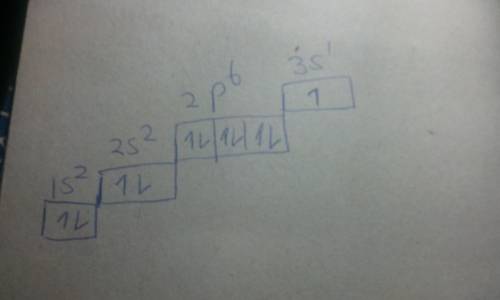
Chemistry, 04.07.2020 01:01 GreenHerbz206
The excited state of an atom is one in which an electron is in a higher energy level (or sublevel) than it is in its ground state (the "normal" electron configuration). The energy level to which the electron transitions must be an allowable energy level (for example an electron cannot transition from a ls to a lp sublevel because the lp sublevel does not exist). An excited state for Na, above its ground state, is [Ne]3p'. When the electron transitions back to the ground state, it emits the yellow-orange light characteristic of Na. The energy of this photon of light is equal to the energy difference between the 3p and the orbital in which the electron is located in the ground state.
a) Draw the ground state electron configuration and orbital filling diagram for Na in its ground state.
b) Another excited state for Na is [Ne]4p'. Which of the following could describe the radiation emitted by the Na atom as it transitions back to the ground state: UV light, the same yellow orange light as described above, red light, or infrared light? Explain.

Answers: 3
Another question on Chemistry

Chemistry, 21.06.2019 17:30
Aspirin has a density of 1.40 g/cm3 what is the volume in cubic centimeters of a tablet weighing 320 mg ?
Answers: 1


Chemistry, 22.06.2019 20:00
The volume of a single vanadium atom is 9.29×10-24 cm3. what is the volume of a vanadium atom in microliters?
Answers: 3

Chemistry, 22.06.2019 20:20
The characteristics of two different types of reactions are shown below: reaction a: electrons are gained by the atoms of an element. reaction b: protons are lost by the atom of an element. which statement is true about the atoms of the elements that participate in the two reactions? their identity changes in both reaction a and reaction b. their identity changes in reaction a but not in reaction b. their identity changes in reaction b but not in reaction a. their identity remains the same in both reaction a and reaction b.
Answers: 1
You know the right answer?
The excited state of an atom is one in which an electron is in a higher energy level (or sublevel) t...
Questions


Mathematics, 23.10.2020 07:01

Mathematics, 23.10.2020 07:01

Mathematics, 23.10.2020 07:01






Biology, 23.10.2020 07:01


Physics, 23.10.2020 07:01

English, 23.10.2020 07:01


Mathematics, 23.10.2020 07:01

Biology, 23.10.2020 07:01


Health, 23.10.2020 07:01

Mathematics, 23.10.2020 07:01




